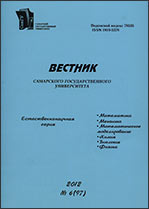|
|
Vestnik SamGU. Estestvenno-Nauchnaya Ser., 2009, Issue 6(72), Pages 139–148
(Mi vsgu266)
|
 |
|
 |
This article is cited in 2 scientific papers (total in 2 papers)
Mathematic Modeling
The discrete time “predator-prey” model
V. V. Zaytcev, A. V. Karlov-junior, S. S. Telegin
Dept. of Radiophysics and Computer Modelling of Radiosystems,
Samara State University, Samara, 443011, Russia
(published under the terms of the Creative Commons Attribution 4.0 International License)
Abstract:
Method of impulse invariance, which is often used to design digital filters, was used to create the discrete time Volterra model with lagging. The predator-prey system was studied as a discrete self-oscillating system. The results of simulation modeling of a system with random lagging are listed.
Keywords:
Volterra model, lagging links, self-oscillations, discrete time.
Received: 17.04.2009
Revised: 17.04.2009
Citation:
V. V. Zaytcev, A. V. Karlov-junior, S. S. Telegin, “The discrete time “predator-prey” model”, Vestnik Samarskogo Gosudarstvennogo Universiteta. Estestvenno-Nauchnaya Seriya, 2009, no. 6(72), 139–148
Linking options:
https://www.mathnet.ru/eng/vsgu266 https://www.mathnet.ru/eng/vsgu/y2009/i6/p139
|

| Statistics & downloads: |
| Abstract page: | 153 | | Full-text PDF : | 71 | | References: | 37 | | First page: | 1 |
|




 Contact us:
Contact us: Terms of Use
Terms of Use
 Registration to the website
Registration to the website Logotypes
Logotypes









 Citation in format
Citation in format 
